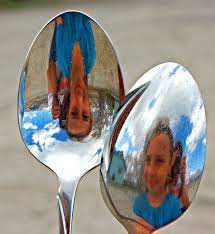Table of Contents
Activity 11.5- Exploring Images in a Spoon
Objective- To understand how curved surfaces, like those of a spoon, form images differently than flat mirrors.
Materials Needed-
- A spoon (which has both concave and convex surfaces).
- An object to observe in the spoon, like a small toy or even your own face.
Procedure-

- Use the Concave Side- First, look at the image of an object or your face in the concave side of the spoon (the inner side).
- Observe and Describe- Notice the size, orientation, and characteristics of the image. Is it upright or inverted? Larger or smaller than the actual object?
- Use the Convex Side- Now, do the same with the convex side of the spoon (the outer side).
- Compare and Contrast- Observe how the image changes. Again, pay attention to the size, orientation, and other features.
Also Check – Class 7 Science -Chapter 15 – Light- Complete Notes
Also Check – Chapter 11- A Detailed Guide to the Light Activities for Class 7 Students
Core Concepts Explained-
- Curved Mirrors- A spoon acts like a curved mirror. The concave side (inwardly curved) and the convex side (outwardly curved) reflect light differently.
- Concave Mirrors-
- Close Up- When you are close to a concave mirror (like the inner side of a spoon), the image appears larger and upright.
- Far Away- As you move away, the image can turn upside down (inverted) and gets smaller.
- Convex Mirrors-
- Always- The image in a convex mirror (like the outer side of a spoon) is smaller than the actual object and always upright, regardless of how close or far you are.
Possible Questions and Answers-
Why does the concave side make things look bigger?
- The concave side of the spoon curves inward, causing the light rays to converge (come together) at a point. This can magnify the image when you’re close.
- Why does the image turn upside down with the concave side when I move back?
- When you move away from the concave surface, the point where light rays converge moves, and beyond a certain distance, the image appears inverted.
Why is the image always upright in the convex side?
- The convex side of the spoon curves outward, causing the light rays to diverge (spread out). This creates a virtual image that is smaller and always upright.
Can we use a spoon to start a fire like with a magnifying glass?
- Theoretically, yes, if using the concave side which can focus light. But it’s not as effective as a magnifying glass.